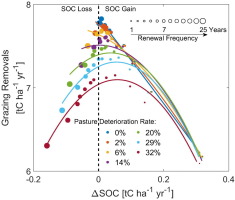当前位置:
X-MOL 学术
›
Sci. Total Environ.
›
论文详情
Our official English website, www.x-mol.net, welcomes your
feedback! (Note: you will need to create a separate account there.)
Modelling the effects of pasture renewal on the carbon balance of grazed pastures.
Science of the Total Environment ( IF 8.2 ) Pub Date : 2020-01-24 , DOI: 10.1016/j.scitotenv.2020.136917 Lìyǐn L Liáng 1 , Miko U F Kirschbaum 1 , Donna L Giltrap 1 , Aaron M Wall 2 , David I Campbell 2
Science of the Total Environment ( IF 8.2 ) Pub Date : 2020-01-24 , DOI: 10.1016/j.scitotenv.2020.136917 Lìyǐn L Liáng 1 , Miko U F Kirschbaum 1 , Donna L Giltrap 1 , Aaron M Wall 2 , David I Campbell 2
Affiliation

|
In New Zealand, pasture renewal is a routine management method for maintaining pasture productivity. However, knowledge of the renewal effects on soil organic carbon (SOC) stocks is still limited. Here we use a process-based model, CenW, to comprehensively assess the effects of pasture renewal on the carbon balance of a temperate pasture in the Waikato region of New Zealand. We investigated the effects of renewal frequency, length of fallow period, renewal timing, and the importance and quantification of age-related reductions in productivity. Our results suggest that SOC change depends on the combined effects of renewal on gross primary productivity (GPP), autotrophic and heterotrophic respiration, carbon removal by grazing and carbon allocation to roots. Pasture renewal reduces grazing removal proportionately more than GPP because newly established plants need to allocate more carbon to re-build their root system following renewal which limits foliage production. That lengthens the time before above-ground biomass has grown sufficiently to be grazed again. New plants have a lower ratio of autotrophic respiration to GPP, however, which partly compensates for the GPP loss during renewal. Our simulations suggested an average SOC loss of 0.16 tC ha-1 yr-1 if pastures were renewed every 25 years, but could gain an average of 0.3 tC ha-1 yr-1 if pastures were renewed every year. For maximizing pasture production, the optimal renewal frequency depends on the rate of pasture deterioration with more rapid deterioration rates favouring more frequent renewal. Additionally, the length of the fallow period, renewal timing, and associated environmental conditions are important factors that can affect SOC temporally, but the importance of those effects diminishes at the annual or longer time scales. A major uncertainty for a full understanding of the renewal effect on SOC lies in the rate of pasture deterioration with time since previous renewal.
中文翻译:

模拟牧场更新对放牧牧场碳平衡的影响。
在新西兰,牧场更新是维持牧场生产力的常规管理方法。但是,关于更新对土壤有机碳(SOC)库的影响的知识仍然有限。在这里,我们使用基于过程的模型CenW来全面评估新西兰怀卡托地区温和牧场的牧草更新对碳平衡的影响。我们调查了更新频率,休假时间长度,更新时间以及与年龄相关的生产力下降的重要性和量化的影响。我们的结果表明,SOC变化取决于更新对总初级生产力(GPP),自养和异养呼吸,通过放牧除碳和向根部分配碳的综合作用。牧草更新比GPP更能减少放牧,这是因为新建立的植物在更新后需要分配更多的碳以重建根系,这限制了叶子的产量。这延长了地上生物量生长到足以再次放牧之前的时间。新植物对GPP的自养呼吸比率较低,但是,这部分补偿了更新过程中GPP的损失。我们的模拟结果表明,如果每25年更新一次牧场,平均SOC损失为0.16 tC ha-1 yr-1,但是如果每年更新一次牧场,则平均SOC损失为0.3 tC ha-1 yr-1。为了使草场产量最大化,最佳更新频率取决于草场退化的速度,退化速度越快,有利于更频繁的更新。此外,休假期的长短,更新时间和相关的环境条件是可能在时间上影响SOC的重要因素,但是这些影响的重要性在每年或更长时间的尺度上都会降低。全面了解SOC的更新效果的主要不确定因素在于自上一次更新以来牧场的退化速度。
更新日期:2020-01-24
中文翻译:

模拟牧场更新对放牧牧场碳平衡的影响。
在新西兰,牧场更新是维持牧场生产力的常规管理方法。但是,关于更新对土壤有机碳(SOC)库的影响的知识仍然有限。在这里,我们使用基于过程的模型CenW来全面评估新西兰怀卡托地区温和牧场的牧草更新对碳平衡的影响。我们调查了更新频率,休假时间长度,更新时间以及与年龄相关的生产力下降的重要性和量化的影响。我们的结果表明,SOC变化取决于更新对总初级生产力(GPP),自养和异养呼吸,通过放牧除碳和向根部分配碳的综合作用。牧草更新比GPP更能减少放牧,这是因为新建立的植物在更新后需要分配更多的碳以重建根系,这限制了叶子的产量。这延长了地上生物量生长到足以再次放牧之前的时间。新植物对GPP的自养呼吸比率较低,但是,这部分补偿了更新过程中GPP的损失。我们的模拟结果表明,如果每25年更新一次牧场,平均SOC损失为0.16 tC ha-1 yr-1,但是如果每年更新一次牧场,则平均SOC损失为0.3 tC ha-1 yr-1。为了使草场产量最大化,最佳更新频率取决于草场退化的速度,退化速度越快,有利于更频繁的更新。此外,休假期的长短,更新时间和相关的环境条件是可能在时间上影响SOC的重要因素,但是这些影响的重要性在每年或更长时间的尺度上都会降低。全面了解SOC的更新效果的主要不确定因素在于自上一次更新以来牧场的退化速度。











































 京公网安备 11010802027423号
京公网安备 11010802027423号